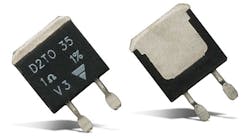Electronic component manufacturers are keeping up with demand for higher performance and longevity to meet stringent application guidelines across all industries—and resistor technology is no exception. As design engineers seek better products to meet harsh environmental conditions and high-precision applications, manufacturers and distributors are answering the call with new technology and the information required to make the most informed buying decisions.
“[Resistor] technology is developing along with application requirements,” says Andy Kerr, vice president of passives for electronics distributor Mouser (Fig. 1). “The resistor manufacturers have had to utilize new materials, new manufacturing processes and meet stringent application guidelines and performance guidelines.… From our side, it’s really about stocking—providing the inventory and availability of these latest technologies. ”
Today’s harsh environments in renewable energy, transportation, and similar fields are demanding more from electronic components in general, and resistors are a staple of the mix. Kerr says he’s seeing resistors that support and handle higher voltages, are more precise, and offer better current sensing as just a few examples. In addition to stocking those products, content is also king. Raising awareness of new technologies and providing customers with resource materials is becoming a more and more important part of the distributor’s job, Kerr explains.
“Because [technology] is expanding so quickly, many engineers know they need something, but they don’t always know what [they need],” Kerr says. “Distributors fill the role of telling them.”
Distributors such as Mouser deliver that content via the Web (with online catalogs, microsites and webinars, for example), through print catalogs, and in person at trade shows and other training events. As Kerr explains, the point is to “get in front of people” as often as you can.
“We need to provide customers the education and awareness of what the newest technologies offer—what they provide that engineer and what benefits they give,” Kerr adds.
Kerr says he sees demand for new resistor technology across all market segments, with a particular focus on automotive, industrial, energy, consumer, and security applications, to name a few. He says customization is another growing trend among resistor manufacturers.
“One of the newer trends is taking developing technology and adapting it for different applications,” he says, pointing to component manufacturer Vishay as an example. Vishay offers custom-made shunt resistors for new applications in smart meters and hybrid electric vehicles (HEVs). “They will take your configuration and mold it, adapt it, or cut the shape into a different shape or form so that it really is a custom-made shunt resistor.”
New Resistors
Vishay Sfernice’s low-profile D2TO35 and D2TO20 surface-mounted power resistors employ thick-film technology, with a wide resistance range of 0.01 to 550 Ω, and are compact and non-inductive. The D2TO35 devices feature 35 W at 25°C (Fig. 2). The D2TO20 resistors offer 20 W at 25°C. Both series are AEC-Q200 qualified. Applications include automotive, industrial welding machines, test equipment, uninterruptible power supplies, basestation systems, and car battery management.
Yageo’s highly reliable low-ohmic chip resistors are optimized for current sensing control. With rated power available from 0.0625 to 3 W, its low-ohmic current sensors are applicable to battery packs, power supplies, and converters. They suit use in the diverse power control circuits of notebook computers or the hard disks of other compact portable devices that have current sensing and over-current protection requirements. Featuring a comprehensive resistance range of 0.5 mΩ to 1 Ω and a superior temperature coefficient, performance is designed to meet various customer demands and applications.
Constructed of a pure carbon film deposited on a high-grade ceramic body, Ohmite’s economical Little Rebels low-wattage resistors offer better stability performance than comparable carbon composition resistors. The Little Rebels are designed for electrical and electronic applications that demand small sizes and small power ratings plus high performance and reliability. They feature high stability, low noise level, and long life and are ideal for applications requiring a steady low-power drop.










